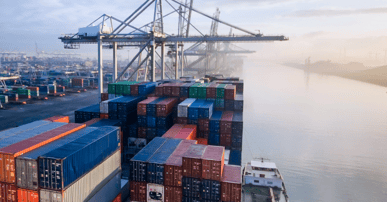Oslo, Norway -- September 28, 2023 -- After a full year of seemingly freefalling ocean freight rates, the latest market data from Oslo’s Xeneta suggests the industry may finally have reached a turning point. According to the Xeneta Shipping Index (XSI®), which tracks real-time rates developments on a month-to-month basis, September saw an increase of 0.2% in valid, global long-term contracted rates. This follows on from 12 consecutive months of falls, which have wiped 62.2% off market prices since August 2022.
Capacity management pays off
“It’s too early to say if this is a fundamental, lasting shift,” comments Peter Sand, Chief Analyst, Xeneta. “But, despite the very small scale of the gain, it’s a significant development after such a prolonged period of decline. The reasons behind that are complex, but a campaign of coordinated capacity management by carriers – restricting capacity on the largest trades – allied to some limited improvement in the demand picture have clearly had an impact.
“In recent weeks and months, we’ve already seen spot rates move above long-term rates on key corridors, suggesting that long-term rates would eventually follow suit and start climbing. It’s still very difficult to predict this dynamic market, especially given the rampant overcapacity, but - if carriers can continue their united, proactive capacity management – this first increase probably won’t be the last. Shippers with the flexibility to negotiate new long-term contracts now should bear that in mind.”
Cautious optimism
Sand points out that evidence of a coming change has been gathering. May’s monthly collapse of 27.5% in the global XSI® was followed by falls of 9.4% and 9.5% in June and July, decreasing to 7.8% in August. At the same time spot rates on the main Transpacific corridor have more than doubled this quarter, largely due to the aforementioned, strict capacity management.
“However,” states Sand, “the good news for carriers will be tempered by the fact that rates are still very low. In fact, the global XSI® is down 16.5% quarter-on-quarter and this will be reflected in the industry’s results for the period, especially with regard to those carriers most exposed to the long-term market. So, yes, there is cause for cautious optimism here, but I’d hardly say the industry is ‘out of the woods’ just yet.”
This point is illustrated by the XSI®‘s regional breakdown of market developments, with as many sub-indices in the red as the black.
High volume focus
In Europe, the sub-index for European imports showed a 1.8% increase from August (59.3% down year-on-year), with the export figure heading in the oppositive direction and falling 2.2% for the month, reaching its lowest level since October 2021. The disparity can probably be explained, notes Sand, by the carrier strategy of focusing on high-volume fronthaul import routes, protecting these key rates by shifting capacity onto lower volume trades.
“It’s an effective tactic when trying to enhance profitability,” he remarks.
The index for Far East exports, the world’s biggest trade and therefore critical when calculating the global XSI®, put an end to 13 consecutive months of falls with a monthly gain of 1.4%. However, as with Europe – and for much the same reason – the backhaul (import) sub-index recorded a comparable loss, falling 1.5%. This benchmark is now at its lowest level since January 2021.
Timing, timing, timing
In the US both the import and export benchmarks fell, the former by 2.3% and the latter by 0.9%. These have now seen respective year-on-year declines of 65.6% and 11.9%. However, despite the on-going long-term falls Sand emphasizes that spot rates have responded to both carriers removing capacity and a pick-up in demand, with the latest available data showing that volumes from the Far East to the US West Coast rose above 900 000 TEU for the first time this year in July. However, this level is still 8.5% down year-on-year.
“Given the current developments there’s a strong imperative for all parties entering contract negotiations to keep a close eye on real-time data,” Sand concludes. “Timing is everything when securing the best deals in a market on the move. If decisions are delayed and rates growth gathers momentum there’ll be a clear price to pay over the duration of these new contracts.”
%201.png)


-1.jpg)
